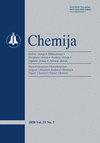刺柏:立陶宛野生和栽培刺柏挥发性有机化合物研究综述
IF 0.4
4区 化学
Q4 CHEMISTRY, MULTIDISCIPLINARY
引用次数: 7
摘要
杜松是一种常见的野生或栽培植物,主要分布在北半球。这种植物是波罗的海地区国家的三种天然针叶树之一,在立陶宛单独生长或形成林分。它是一种常绿、长寿的灌木或小树。杜松根据植物的起源、器官和发育阶段,合成各种(定量和定性)挥发性有机化合物。精油是由杜松子的不同部分制成的。杜松子是共产主义者的果实,可能是该植物最有价值的部分,富含精油。它们的制剂传统上在民间医学和兽医中用作防腐剂、利尿剂、抗蠕虫、抗真菌、抗风湿、抗菌、滋补和抗炎药。本文综述了从立陶宛不同地区野生生长(或栽培)的杜松的各种植物器官(芽、茎、成熟和未成熟的浆果、叶子、木材和树皮)中获得的精油化学成分数据。阿尔法α-蒎烯是立陶宛杜松精油中最常见的成分。这种单萜烃被评估为大多数研究油中的主要化合物,这些油是从杜松芽、芽、针叶和球果(包括未成熟和成熟的)中获得的。本文章由计算机程序翻译,如有差异,请以英文原文为准。
Juniperus communis L.: A review of volatile organic compounds of wild and cultivated common juniper in Lithuania
Juniper (Juniperus communis L.) is a common wild or cultivated plant, mainly distributed in the Northern hemisphere. The plant, being one of three natural conifers in the countries of the Baltic Sea region, grows separately or forms stands in Lithuania. It is an evergreen, long-lived shrub or a small tree.
Juniper synthesizes various (quantitatively and qualitatively as well) volatile organic compounds depending on the plant origin, organ and developing stage. Essential oils are prepared from different parts of juniper. Juniper berries, the fruit of J. communis, perhaps the most valuable part of the plant, are rich in essential oils. Preparations of them are used traditionally in folk medicine and veterinary as antiseptic, diuretic, anti-helminthic, anti-fungicidal, anti-rheumatic, antibacterial, tonic and anti-inflammatory remedy.
This paper reviews the published information concerning data on the chemical composition of essential oils obtained from various plant organs (sprouts, shouts, ripe and unripe berries, leaves, wood and bark) of junipers wild growing (or cultivated) in different localities in Lithuania. Alfa α-pinene is the most common constituent determined in Lithuanian juniper essential oils. This monoperpe hydrocarbon was evaluated as a predominant compound in most of investigated oils, obtained from juniper shoots, sprouts, needles and cones (both unripe and ripe ones).
求助全文
通过发布文献求助,成功后即可免费获取论文全文。
去求助
来源期刊

Chemija
化学-化学综合
CiteScore
1.30
自引率
16.70%
发文量
14
审稿时长
>12 weeks
期刊介绍:
Chemija publishes original research articles and reviews from all branches of modern chemistry, including physical, inorganic, analytical, organic, polymer chemistry, electrochemistry, and multidisciplinary approaches.
 求助内容:
求助内容: 应助结果提醒方式:
应助结果提醒方式:


